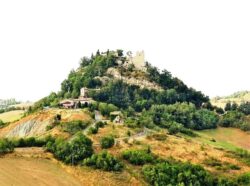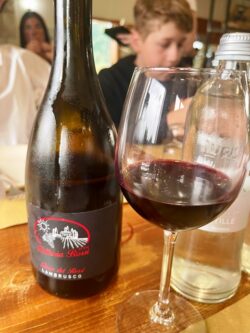Home » Browse » Food For Thought » Food For Thought: What We Owe To Matilde di Canossa
July 9, 2025 - Written by: Nancy PollardRead Time: 4 Minutes Subscribe & Share
Andare a Canossa
 My fleeting memory of Matilde of Canossa was an image in my high school European history book: Henry IV, of the Holy Roman Empire, not the French or English ones—doing his shame walk barefoot in the snow, outside her castle, as a mark of penance to Pope Gregory VII. Some accounts credit his wife, Queen Bertha, and his son, Prince Conrad with accompanying him. The Pope was staying with Matilde, and Henry had been excommunicated for trying to appoint his own bishops. I vaguely remembered that he wore the extremely uncomfortable hair shirt -usually made from prickly goat fur worn next to the skin – an early and painful example of political PR.
My fleeting memory of Matilde of Canossa was an image in my high school European history book: Henry IV, of the Holy Roman Empire, not the French or English ones—doing his shame walk barefoot in the snow, outside her castle, as a mark of penance to Pope Gregory VII. Some accounts credit his wife, Queen Bertha, and his son, Prince Conrad with accompanying him. The Pope was staying with Matilde, and Henry had been excommunicated for trying to appoint his own bishops. I vaguely remembered that he wore the extremely uncomfortable hair shirt -usually made from prickly goat fur worn next to the skin – an early and painful example of political PR.
This whole episode, part penitential theater and part power struggle, marked a pivotal shift in medieval Europe. The ongoing battle between papal authority and monarchs—especially over who held the right to appoint Church officials—was already heated. Matilde of Canossa, ruling a strategically vital territory in central Italy, managed to place herself at the very heart of the conflict, mediating between the Papacy and the Empire with remarkable success.
N,B, andare a Canossa or go to Canossa has come to mean in Italian and English to humble yourself to an adversary to schieve a goal, often under coercion.
 We were returning home from a lovely weekend in the mountains when the historically literate member of the family insisted we visit what remains of Matilde’s 11th-century castle, perched dramatically on a staggeringly difficult-to-reach promontory in Reggio Emilia. It was there that I learned she had been far more than a happenstance mediator.
We were returning home from a lovely weekend in the mountains when the historically literate member of the family insisted we visit what remains of Matilde’s 11th-century castle, perched dramatically on a staggeringly difficult-to-reach promontory in Reggio Emilia. It was there that I learned she had been far more than a happenstance mediator.
Matilde inherited a swath of territory stretching across Lombardy, Emilia-Romagna, and Tuscany after the deaths of her siblings, and ruled it well for six decades. She aligned herself politically with the Papacy, deftly navigating the territorial ambitions of neighboring kingdoms. She was literate in Latin, wrote her own correspondence to the powerful figures of medieval Europe, and was fluent in German and French. She also supported music and poetry, and—perhaps my favorite legacy—she laid the groundwork for many of the food traditions that still define the region today.
Compartecipanze Matildiche
One of her most forward-thinking policies was a remarkable agricultural land management system—parts of which survive to this day in Italy. Continuing her father’s land reclamation efforts, she oversaw the rehabilitation of fields damaged by war or exhausted by overcultivation. These plots were then distributed to farming families for nine-year terms before being reassigned. This ensured sustained food production, avoided land hoarding, and helped revitalize rural economies.
to this day in Italy. Continuing her father’s land reclamation efforts, she oversaw the rehabilitation of fields damaged by war or exhausted by overcultivation. These plots were then distributed to farming families for nine-year terms before being reassigned. This ensured sustained food production, avoided land hoarding, and helped revitalize rural economies.
She also invested heavily in infrastructure: building roads, bridges, and religious institutions that doubled as trade hubs and sources of local stability. Her reign saw the construction of around 136 churches, monasteries, and nunneries. She even established hospitals for the poor and pilgrims—a reminder that compassion and political acumen are not mutually exclusive.
In a region already rich in culinary promise, Matilde’s policies encouraged the preservation and development of local food traditions. Farms with cows and pigs produced not just fresh food but also preserved staples—milk became cheese, and no part of the pig went to waste. Recipes were recorded and eventually found their way into the libraries of feudal courts. Her protectionist stance on local food production not only secured supplies but also revenues, as trade flourished. She bolstered this network by constructing a series of fortified castles—each in visual contact with the next—strategically placed near mountain passes and key roads. These served as both military outposts and administrative centers, reinforcing her governance across the region.
Matilde is credited with encouraging the cultivation of the Lambrusco grape—one of the few truly wild grapes native to this part of Italy. She urged the monks in her monasteries to propagate and domesticate it in order to make wine. The result was a lightly sparkling red one, worlds apart from the cloying Lambrusco that made its way to American grocery shelves in the mid-20th century that was engineered to appeal to Coca-Cola drinkers.
part of Italy. She urged the monks in her monasteries to propagate and domesticate it in order to make wine. The result was a lightly sparkling red one, worlds apart from the cloying Lambrusco that made its way to American grocery shelves in the mid-20th century that was engineered to appeal to Coca-Cola drinkers.
While one member of our group (not the historically literate one) turned up his nose, I found myself delighted by the dry, fizzy Lambrusco we drank at Fattoria Rossi, just below Castello Canossa. Paired with their delicious salumi and gnocco fritto, it was—dare I say—a revelation. You’ll want to fortify yourself with both before attempting the climb to Matilde’s castle.
Vinegar and Vindication
One final note on Matilde’s gastronomic legacy: one of the earliest recorded mentions of aceto balsamico—yes, that precious vinegar—comes from the court of her father, Boniface. In 1046, he gifted a bottle to Henry III (yet another Holy Roman Emperor). While Matilde isn’t named in the record, the detail speaks volumes: the art of balsamic vinegar production was already well-established in her family’s court.
At the small museum near the Castello Canossa ticket office, I had the pleasure of a personal tour showing the traditional methods of balsamic production, with three variations involving a six-barrel aging system in descending sizes. One of the barrel systems bore the name Cavalli—the maker of the balsamic I had chosen years earlier at a tasting in New York as my favorite and that we subsequently sold in the store. I felt vindicated.

Kitchen Detail shares under the radar recipes, explores the art of cooking, the stories behind food, and the tools that bring it all together, while uncovering the social, political, and environmental truths that shape our culinary world.




Just an unrelated question. I used to go to your store quite often, but once a year, over many years, I would come and purchase a copper pot – much to my wife’s chagrin (Money is for saving, not spending!). Are there any stores that you are aware of that are similar to your magnificent store?
I’ve not found one. If anyone knows any place like it, please let us all know.
Hello Mark, I never get tired of reading about La Cuisine from clients! To answer you and Jennifer, I have looked up some of my suppliers to see where whom they are working with in the US. Mauviel now is selling directly trom its US website, as does De Buyer. I have tried looking up similar stores in the US, but I always get the usual suspects – which are more kitchen lifestyle stores. But I will pass along any finds. Do let me know what you are looking for in particular as I still keep in touch with what… Read more »